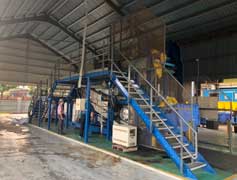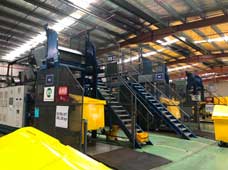Managing medical waste from the Covid-19 pandemic no longer an uphill task
by Cheryl Ng
The pandemic has caused the volume of medical waste globally to increase faster than we can safely dispose of it. Thankfully there is a safe, environmentally-sound solution at hand.
In March 2020, the World Health Organisation (WHO) urged that the production of PPE be escalated by 40% to meet modelled estimates of 89 million medical masks, 76 million examination gloves, and 1.6 million goggles required to respond to and counter Covid-19 each month (1).
As a result, the volume of medical waste globally began to escalate at unprecedented rates.

Hospitals in Wuhan, the epicentre of the Covid-19 outbreak, produced more than 240 tonnes of single-use plastic-based medical waste per day at the peak of the pandemic – about the weight of an adult blue whale; this is six times more the daily average before the global health crisis set in (2). Cities in Asia such as Manila, Hanoi and Bangkok experienced similar increases, producing 154 to 280 tonnes more medical waste per day than before the pandemic (3).
What is medical waste?
Medical waste includes infectious waste such as waste contaminated with blood and other bodily fluids, pathological waste such as resected human tissues, sharps waste such as syringes, chemical waste such as reagents used for laboratory preparations, or pharmaceutical waste such as expired drugs. The major sources of medical waste are hospitals, research laboratories, mortuary and autopsy centres, animal research and testing laboratories, blood banks, and nursing homes for the elderly (4).
Read: Medical Industry: Medtech market given the all clear for expansions
Of the total amount of waste generated by health care activities, about 85% is general, non-hazardous waste comparable to domestic waste. The remaining 15% is considered hazardous material that may be infectious, chemical or radioactive (4).
Certainly, in an infectious disease pandemic, the line between general and hazardous waste becomes blur. Waste that is not usually considered medical waste such as leftover food, must now be disposed of carefully if it has been in contact with Covid-19 patients or the healthcare practitioners that care for them.
How is medical waste treated?

Contaminated waste from healthcare facilities is typically burned, sterilised with steam and/ or chemically treated before being transported to a landfill, but these treatment methods are far from ideal.
While incineration of waste has been widely practiced, often materials that are unsuited for incineration are incinerated, or incineration is performed inadequately, that the waste releases pollutants into the air and/ or generate ash (4).
Sterilisation with steam consumes large amounts of water, a valuable resource, and is not recommended by the WHO nor the United Nations (UN), while treating waste with chemical disinfectants can potentially damage the environment if these substances are not handled, stored, and/or disposed of in an environmentally sound manner (4).
Regulations on the treatment and disposal of medical waste vary from country to country. While governments are legally obligated to safely dispose of medical waste, safe waste disposal could be challenging for developing countries without standard waste management technologies and appropriate waste emergency policies. In 2015, a joint WHO/UNICEF assessment found that just over half (58%) of sampled facilities from 24 low- and middle-income countries had adequate systems in place for the safe disposal of medical waste (4).
Enter AMB Ecosteryl, a revolutionary medical waste management technology

Using innovative microwave or dry heat technology, AMB Ecosteryl provides a responsible, environmentally-friendly and sustainable solution to waste management for the medical and healthcare industry. Ecosteryl machines run on electricity only, producing no toxic by-products from the treatment process, such as water, steam, fumes, gases, or chemical emissions.
The process reduces the volume of waste by 80% and renders its residue sterile and inert, which is then easily integrated into conventional waste management channels, landfilled and/ or recycled. It can also be used as fuel to generate electricity, or even in the production of cement.
All this is done within a space no bigger than a double-decker bus. The smallest of the models, Ecosteryl-75, is only one-quarter the size of a double-decker bus but it can treat 75kg of medical waste per hour. On average, a 300-bed hospital can generate 2,100kg of medical waste per week – which means that running the machine for just 28 hours a week could create a sustainable, circular solution for the hospital’s own waste.

Advantages of Ecosteryl machines are multifold: it is easy to install, highly efficient, safe, suitable for hospitals and small-sized waste management service providers, and as it requires low maintenance, the operator can reduce labor and operating costs. More importantly, because it transforms medical waste into an entirely recyclable product, healthcare facilities can continue to purchase and consume one-time use products even as governments tighten environmental regulations and set limits on the corporate carbon footprint.
Today there are more than 170 Ecosteryl machines installed in 60 countries worldwide, including in Malaysia, where they launched its first non-incineration clinical waste treatment center in 2014. This was in partnership with Kualiti Alam, a Cenviron company in charge of waste management services for the entire country.
In Malaysia, clinical waste is classified as scheduled waste, which is controlled under the Environmental Quality (Scheduled Wastes) Regulations 2005 (5), necessitating Ecosteryl to work closely with a local partner to ensure all aspects of medical waste management were aligned with the prevailing national regulations, from storage, collection, transportation, treatment, to disposal.
Today, there are nine Ecosteryl machines in four treatment centers in Malaysia processing 90% of the country’s medical waste.
Environment and Water (Kasa) Minister Datuk Seri Tuan Ibrahim Tuan Man reported that clinical waste increased by 20% since the Covid-19 outbreak in the country (6). However, the country leverages upon its existing medical waste disposal infrastructure well: waste such as disposable plastic generated from government-gazetted health facilities and Covid-19 quarantine centres are gathered and disposed of at plants with environmental pollution control technology (6). An additional local study also concluded that the clinical waste management in government hospitals followed existing guidelines for the management and disposal of Covid-19 waste, with some additional precautions and rules by the waste management contractors (7).
As of 1 December 2020, the global tally of Covid-19 cases stands at 64.2 million and has claimed almost 1.5 million deaths, continuing to climb at an exponential rate (8).
As the pandemic grows, so will the waste, and keeping that garbage safe and contained will continue to be a challenge for communities way after the crisis becomes more manageable, underlining the urgent need for concerted effort towards a more circular economy.
Ecosteryl technology is certified worldwide and recognized as the most cost-effective and eco-friendly solution for medical waste treatment by WHO, UN and World Trade Organization (WTO). Ecosteryl is participating in Medical Fair Asia (MFA) 2020 (held from 9-18 December 2020) as part of the EU Business Avenues in South East Asia program, which supports European companies aiming to expand their presence in Southeast Asia.
2. https://science.sciencemag.org/content/369/6509/1314
3. https://eprints.gla.ac.uk/219113/1/219113.pdf
4. https://www.who.int/news-room/fact-sheets/detail/health-care-waste
5. http://doi.org/10.26480/jwbm.02.2019.01.04
7. https://journals.sagepub.com/doi/abs/10.1177/0734242X20959701





